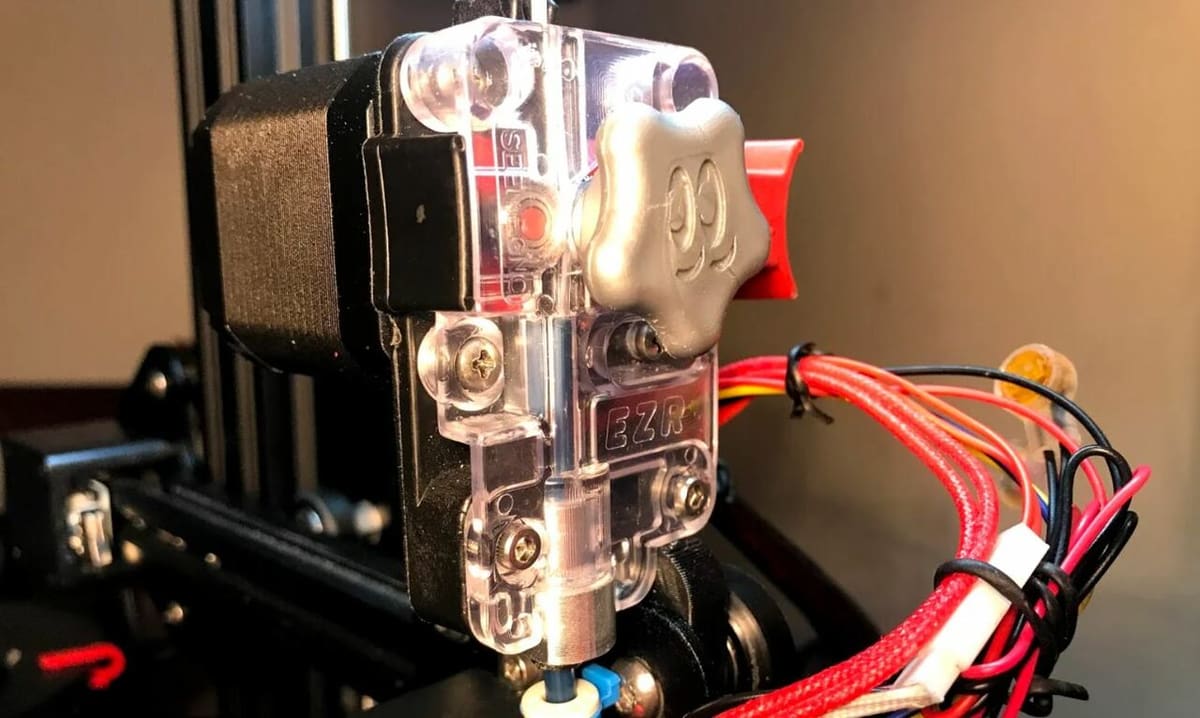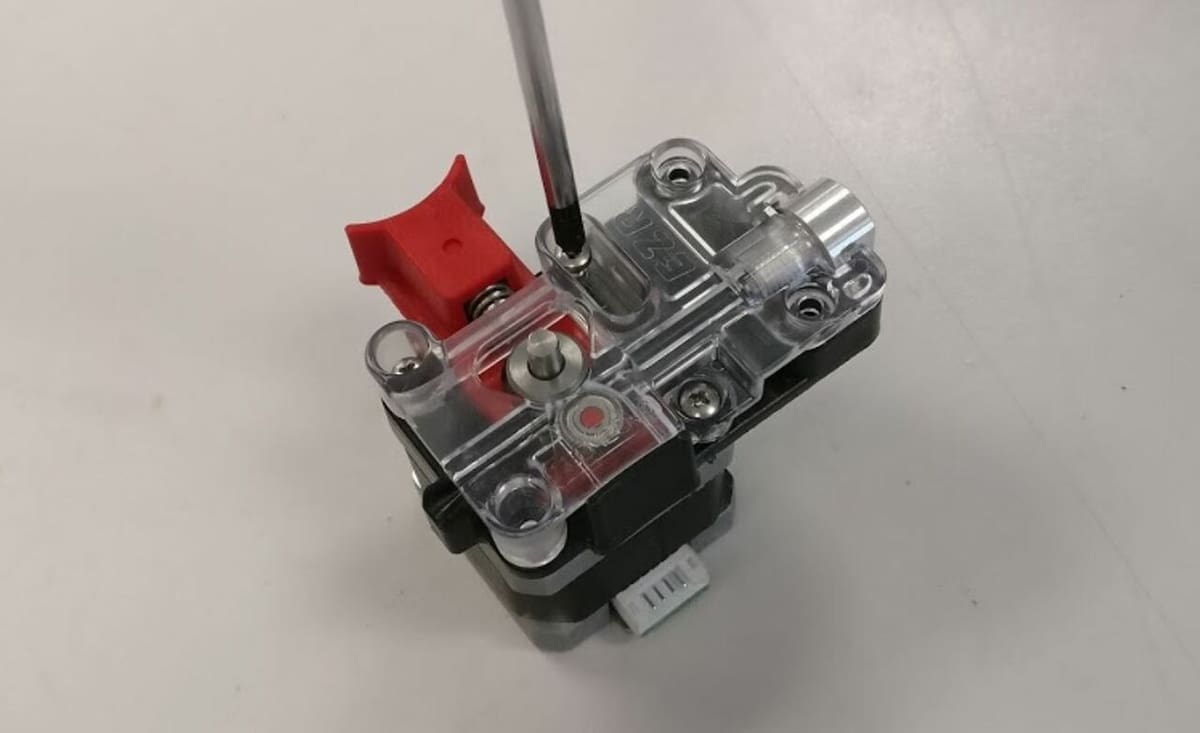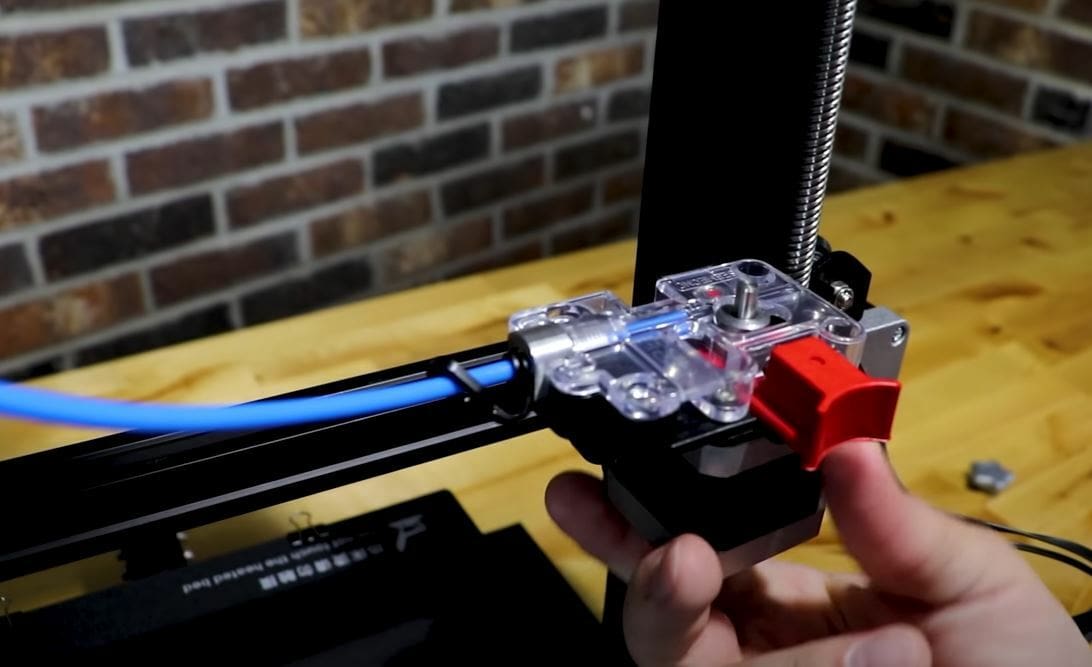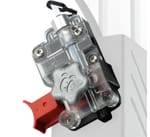Emphasis on EZ

In 3D printing, the machine’s extruder connects to a motor to push the filament material into the hot end. These vital parts can make or break a print and are often the cause of print failures. For this reason, it’s very important to use a high-quality extruder.
While many after-market extruders exist, one that stands out for its ease of use and reliability is the SeeMeCNC EZR Struder. Note that despite its name, this extruder is for 3D printers, not CNC machines. It’s made by SeeMeCNC, a company that develops and manufactures 3D printers and printing supplies. The EZR Struder is an improved and revised version of SeeMeCNC’s original version, enhanced to handle flexible materials.
The SeeMeCNC EZR Struder typically costs around $40 and is a single-drive extruder, meaning it uses one hobbed drive gear to push filament, with an idler wheel to allow the filament to move.
This extruder has many great features, but we’ll look at a couple in detail. After that, we’ll also go over how it compares to another well-known extruder, give you some specs, and finally, show you where to buy it. Let’s get started!
Features

Let’s take a look at the main features that make SeeMeCNC EZR Struder unique.
Easy Filament Loading
If you say the name “EZR Struder” out loud, you’ll probably hear “easier” in the name, a nod perhaps to how easy it is to load filament. A few features contribute to this, including the tension release lever, see-through frame, and the extruder handwheel.
First, while most extruders have a filament tension release system, the EZR Struder uses a simple button that won’t snap (unlike a flimsy lever). Additionally, you can operate the button with only one hand, leaving your other hand free to control the filament.
Second, the see-through frame on the Struder makes the filament-loading process super easy. Filament can bend inside an extruder and misses the exit hole, but the clear casing allows you to see exactly where your filament is.
Third, the handwheel can move filament in or out of the extruder. This allows you to quickly change filament without contaminating it with moisture or particles from your hands, as this could disrupt the print quality.
Open-Source Compatibility and Mounting
Next, another great feature of the EZR Struder is that it’s open source, so many 3D models for this extruder (including modifications, upgrades, and fixes) are available to the public. Predictably, there are many mounts available to add this extruder to different 3D printers. Even better, the stock EZR Struder comes with six spaced-out mounting holes for screws, making it compatible and easy to mount on many machines straight out of the box!
However, as pointed out by Teaching Tech, if you have an upgrade around your printer’s original extruder, some modification may be necessary. Besides working around current upgrades, installing the EZR Struder should only take a few minutes. You can check out SeeMeCNC’s assembly guide to learn more.
PTFE Fitting and Coupler
Finally, the EZR Struder has a few special offerings relating to PTFE (or Bowden) tubing.
To start, there’s a PTFE tube that passes through most of the extruder (similar to the PTFE liner found in many hot ends). Not many other extruders include this but it keeps the filament’s journey very smooth and mimizes friction. This element on the EZR Struder is very appreciated by users like CHEP, who highlighted how the internal PTFE tubing prevents flexible materials from easily escaping the extruder.
The EZR Struder works with standard 4-mm OD (outside diameter) PTFE tubing, which is the same size tube as many of Capricorn’s PTFE tubes. You can easily insert the tubing into the extruder, and this will close the remaining space that isn’t already covered by the PTFE tube liner.
The last feature is the connectors that come with the EZR Struder and look like mini flexible wrenches. These plastic pieces are designed to keep the inserted PTFE tube in place by providing another connection point to the extruder (besides the pneumatic fitting insider the extruder). To use them, insert the PTFE tube through the connector’s hole into the extruder, and then clip the open-circle part of the connection piece to the PTFE tube.
The Bottom Line

Now that you know the features and qualities of the SeeMeCNC EZR Struder, we’ll compare it to a similar product to learn more about its strengths and weaknesses: the popular E3D Titan extruder.
The first point of comparison between the two products is their extrusion: how well they reliably extrude filament. The EZR Struder is pretty average concerning its extrusion, utilizing a standard 1:1 gear ratio and a single-drive mechanism. In contrast, the E3D Titan extruder uses a 3:1 gear ratio which supplies more torque (pushing force) than a typical 1:1 ratio.
Moreover, a few users have also experienced skipping on their EZR Struder. It wasn’t due to a hot end clog, which could mean that the extruder wasn’t providing enough force. For this reason, the E3D Titan extruder is probably better for high-force extrusion and to prevent under-extrusion.
Second, the EZR Struder is a very easy-to-use extruder that enhances and smooths the filament-changing process. With its see-through frame, handwheel, and release button, the EZR Struder earns high marks from many users, like TeachingTech, for its ease of use. The E3D Titan contains a release lever that’s harder to use than the EZR’s button, and it lacks a clear frame and handwheel.
Third, both extruders are open-source and compatible with a variety of printers. Many upgrades and modifications have been made by 3D printing enthusiasts for either option. However, one difference is that the EZR Struder comes with more mounting screw holes than the E3D Titan, which only has four.
Lastly, the seemingly minor details of a product play a role in determining its quality, and both the EZR and Titan contain a few small but helpful design elements. For the EZR Struder, the PTFE liner prevents filaments, especially flexible ones, from escaping the extruder chamber and wasting filament. Also, the backup PTFE connector reduces the chances of the tubing disconnecting.
While the E3D Titan doesn’t have these PTFE tube elements, it does have an adjustable extruder tension knob. This knob allows you to change the extruder’s tension (grip) on the filament, which can be used to prevent filament grinding and under-extrusion.
Overall, the EZR Struder and E3D Titan extruders are both great options. If you want more power, the E3D Titan (or another geared extruder) is a better option due to its torque-improving gear ratio. However, the EZR Struder is slightly cheaper and very easy to use, making the filament-changing process quick and easy.
Specifications

Below is a list of the SeeMeCNC EZR Struder’s features and specifications:
- Drive gears: 1 (single drive)
- Compatible configurations: Bowden drive or direct drive
- Compatible filament diameter: 1.75 mm
- Compatible filaments: PLA, ABS, PETG, TPU, and more (not glow-in-the-dark, according to SeeMeCNC)
- Compatible motor: NEMA 17 stepper motors (5-mm shaft)
- Extruder hand knob: Yes
- Tension release: Yes
- Transparent: Yes
- Mounting: M3 screws
- PTFE tube: Includes PCT coupler; works with standard 4-mm OD PTFE tubing
- Made in: United States
Where to Buy

You can purchase an authentic SeeMeCNC EZR Struder for around $40 from a retailer below:
Lead image source: juniors3Dprint via Twitter
License: The text of "SeeMeCNC EZR Struder: Review the Specs" by All3DP is licensed under a Creative Commons Attribution 4.0 International License.
CERTAIN CONTENT THAT APPEARS ON THIS SITE COMES FROM AMAZON. THIS CONTENT IS PROVIDED ‘AS IS’ AND IS SUBJECT TO CHANGE OR REMOVAL AT ANY TIME.



